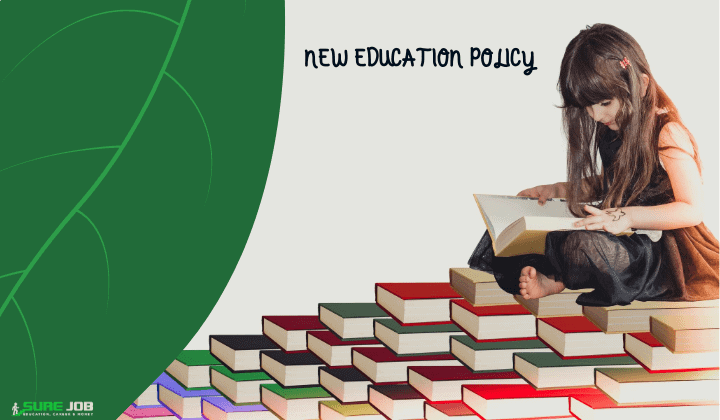In July 2020, the Cabinet approved the new National Education Policy (NEP) with an aim to overhaul education in India and the overall education sector. This is the first major national policy on education after a gap of nearly 34 years.
It lays down guidelines for India to achieve near total literacy by the year 2030. Furthermore, the National Education Policy also upholds various provisions and rights enshrined by the Constitution of India.
At the same time, some of the beneficial provisions of earlier educational policies will remain in force, even after the National Education Policy-2019 goes into effect after ratification by the Cabinet in July this year, even as India battles the global Covid-19 pandemic.

Constitutional Basis for Educational Policies in India
All educational policies enacted by the Central and state governments as well as Union Territory administrations are based on laws contained in the Constitution of India.
Therefore, to understand the new education policy and other existing policies, we need to understand what’re the constitutional compliances?
Free, Compulsory Education
Article-45 of the Directive Principle of State Policy calls for the Indian government and its various branches to enforce free and compulsory education to all citizens, till their age of 14 years.
The directive went into force way back in 1960. Unfortunately, several hurdles at various level have delayed its full implementation.
Under this directive, the Central and state governments as well as Union Territory administrations are to make adequate provisions such as opening primary and secondary schools in cities, town and villages to enable students up to 14 years to avail free education.
The directive and its enabling laws make it compulsory for all parents and wards below the age of 14 years to educate their children at these schools.
Education of Minorities
The Preamble of the Constitution of India accords equal rights to all peoples of this country, regardless of the basis of caste, creed, religion or sect.
Article-30 of the Indian constitution upholds the right to cultural freedom at educational institutions. The section also enables minority communities to establish educational institutions that conform to their culture and tradition as well as religious teachings, where applicable.
Furthermore, Article-30 outlaws discrimination in funding, grants and other facilities to educational institutions established by minority communities.
They will receive the same funding, grants and status as secular or non-religious, non-communal educational institutions in the country, regardless of any other parameters.
Preservation of Native Language
Article 29 (1) of the Indian constitution calls for preservation of native languages regardless of its script, ethnicity and locality of usage among other elements.
The Article 350 (B) mentions that states shall appoint local Linguistic Officers to ensure that languages spoken by any minority community in the country is conserved appropriately.
Education of Economically, Socially, Educationally Backward Classes
Articles 15, 17, 46 of the Constitution of India protect the educational interests of the socially and educationally backward classes of citizens and scheduled castes and scheduled tribes.
Article 15 states, “Nothing in this article or in clause (2) of Article 29 shall prevent the state from making any special provision for the advancement of any socially and educationally backward classes of citizens or for the scheduled castes and the scheduled tribes.”
Article 46 says that the Central government is responsible for the economic and educational development of the Scheduled Castes and Scheduled Tribes.
It says “The state shall promote with special care the educational and economic interests of the weaker sections of the people and in particular, of the Scheduled castes and Scheduled Tribes and shall protect them from social injustice and all forms of exploitation.”
Secular Education
The Constitution of India allows students from every community to attend schools and colleges without the burden of following a specific religious practice followed by that educational institute.
Article 25 (1) of the Constitution of India guarantees freedom of independent conscience, right to practice, profess and propagate religion.
Article 28 (1) says: “No religious instruction shall be provided in any educational institution if wholly maintained out of state fund.”
This means, the Central, state governments and Union Territory administrations will not provide funds to fully finance an educational institute founded on religious lines.
However, it can provide partial funding and grants. This means, the state accords equal importance to all religions in this country.
Article 28 (3) gives freedom of religion to students who’re enrolled at educational institutions receiving part or full funding from the governments. Students aren’t compelled to follow religious instruction in any manner by any educational institution.
Article 28 (1) says: “No person attending any educational institution by the state or receiving aid out of state funds, shall be required to take part in any religious instruction that may be imported in such institutions or to attend any religious worship that may be conducted in such institution or in any premises attached thereto unless such person or, if such person a minor, his guardian has given his consent thereto.”
Article 30 of the Indian constitution makes it illegal for the Central and state governments, UT administrations to fully finance any religious educational institute or deny partial funding and grants on lines of caste, creed, ethnicity, religion and sect, among other lines.
Guarantee of Equal Opportunities
Article 29(1) guarantees equal opportunities to admission and entry to every educational institution that’s fully or partly funded by the government.
This means, a state-run school, college and university cannot deny admissions on basis of caste, creed, ethnicity, religion and sect to any student.
At the same time, this law doesn’t take away the right of a school, college or university, either partly or fully to permit admissions on lines of merit such as entrance exams that’re approved by the government and comply with all requirements of the Indian constitution.
However, these educational institutes can provide a limited number of seats to students through Reservations quota for socially, economically and educationally underprivileged sections of the society and minority communities where applicable.
The Reservations quota has to comply with related clauses of the Constitution of India that guarantee equal rights to all citizens and clauses for uplift of underprivileged classes.
Medium of Instruction (MOI)
Article 26 (1) says: “Any section of the citizens, residing in the territory of India or any part thereof, having a distinct language, script or culture of its own, shall have the right to converse the same.”
Article 350 A says: “It shall be the endeavour of every state and every local authority to provide adequate facilities for instruction in the mother-tongue at the primary stage of education to children belonging to linguistic minority groups.”
These two clauses make it mandatory for state and regional governments to ensure that educational facilities are available in the native tongue (mother tongue) of a student, where possible.
At the same time, educational institutions have the freedom to choose their Medium of Instruction (MOI) depending upon demographics and demand.
Hence, the Central and state governments can fully or partially fund educational institutions that use any MOI.
Education in Hindi
Article 351 of the Constitution of India calls for promotion of Hindi as the national language, though it doesn’t specifically say this has to be done through state funded educational institutions.
However, with the widespread use of Hindi after its adoption as the National Language of India, government funded schools should offer it as one of the subjects in the syllabus.
Institutes of National Importance
The Indian constitution also lays emphasis on research and development and calls upon the government to accord special status to educational institutions that excel in this field. Hence, there’re now several Institutes of National Importance in India.
All Institutes of National Importance come under the Department of Higher Education at the Ministry of Education.
By mid-2020, there were a total of 95 Institutes of National Importance across the country. There’re various parameters to designate an educational institutes under this category.
There’re plans to include educational institutions operated by Indian Space Research Organization (ISRO) under this category too.
Education for Women
Two clauses of the Constitution of India explicitly lay emphasis on education of women in India.
Article 15(1) abolishes discrimination against any individual on basis of sex. In recent years, the Indian government has also taken steps to include transgender community into mainstream of education.
Article 15 (3) says: “Nothing in this article shall prevent the State from making any special provision for women and children.”
Additionally, other laws and applicable clauses of the Indian constitution for women empowerment in India also define the educational policies.
At the same time, educational institutions that cater specifically and exclusively to women students can also be set up or funded by Central and state governments under these clauses.
Other Important Laws & Clauses
One of the significant education policy in India is now the Midday Meal Scheme (MMS). Under the MMS, all schools that’re funded partly or fully by the Central or state governments, UT administrations will be providing free midday meals to all students.
These meals are funded by the government and currently outsourced from Self Help Groups, especially those run by women.
This is in line with women empowerment clauses and protection of child rights as well as clauses regarding health.
The Constitution of India also allows foreign students to get admissions at educational institutes in the country.
These laws are decided by other clauses too such as India’s bilateral relations with a foreign country.
These clauses and articles also decide educational exchange programs between India and a foreign country.
Grant of scholarships by private parties at educational institutes fully or partly funded by the Central and state government is also permitted. However, the government school as well as the donor has to obtain due clearances from concerned authorities for offering these scholarships.
Extracurricular activities at schools and colleges also come under the broad umbrella of the Constitution of India. They’re governed by education policies as well as healthcare and other prevailing laws at the time.
Educational Policies in India
As we can see, the educational policies in India aren’t random or made arbitrarily. They have to comply with the articles and provisions of the Constitution of India and various other laws that prevail at the time.
Right to Education Act-2009
The Right to Education (RTE) Act 2009 is the prime law that governs all education in India. Under the RTE policy, every person regardless of age, gender, caste, creed, religion, sect or location and background have the right to education.
This Act enshrines the Constitutional requirement of free, compulsory education.
Aanganwadi Workers (Employment & Welfare Act)
This Act empowers Aanganwadi workers and children at Aanganwadis in rural India to basic Kindergarten type education. It also provides children with meals at Aanganwaadis to combat malnutrition. This is an initiative by the Ministry of Women & Child Development.
Adult Education Policy
The Adult Education Policy of India is governed by the Ministry of Human Resources & Development (MHRD).
It stipulates that every adult citizen of the country has a right to basic education and strives to promote literacy, increasing the number of literate population in the country.
This policy seeks to overcome low literacy rates among grown-ups that missed school education for any reason.
Child Labour Act & Various Policies
The Indian law strictly forbids employment of persons below the verifiable age of 14 years. In such cases too, a teenager between 14 years and 18 years cannot be employed in specific hazardous industries and jobs.
At the same time, the Child Labour Act and related policies make it obligatory for employers of teenage workers to send them to evening school, provide adequate time for studies and bear certain kinds of expenses in addition to wages.
This law is enforced by Ministry of Labour and Employment.
Kendriya Vidyalaya Sangathan
In 1962, the Central government established the Kendriya Vidyalaya Sangathan (KVS) in a bid to standardize education for government employees with transferable jobs.
These include students whose one or more parent works with the Indian Armed Forces, Paramilitary Forces, Indian Foreign Service and other branches.
NCC Act and NSS Act
The National Cadet Corps Act and National Service Scheme Act come as part of Indian government’s policy to provide education in extracurricular activities and develop soft skills.
NCC and NSS are voluntary organizations that operate under the Indian government.
Membership to NCC and NSS is voluntary and implemented through secondary schools and colleges.
Skill India
Launched in 2015, Skill India is a policy through which the Central government aims at providing vocational education to millions of Indian youth with the aim of preparing them for the domestic and international job markets.
The government has already tied-up with education providers in UK, Japan and France for this drive.
NSF Tab Program
A pilot project known as the NSF Tab Program was launched by the Indian government as public-private partnership.
Under the NSF Tab Program, school students across India are to be provided preloaded and tamperproof tabs that make learning easy and fun.
The program aims at implementing e-learning facilities at Indian schools that’re plagued by shortage of teacher.
Beti Bachao- Beti Padhao & SSY
Launched in 2015, this policy of the Indian government aims at getting rid of ancient taboos associated with having girl child, female feticide and gender bias in education.
The Beti Bachao- Beti Padhao policy aims at encouraging people to send their girls to school and higher education.
A follow-up initiative, Sukanya Samriddhi Yojana is also implemented by the Indian government to provide adequate funds to girl students.
The SSY is a savings bank account that parents can open for a girl child at any post office or participating banks. The government contributes 8.1 percent interest.
Only 50 percent of the funds can be withdrawn for specific purposes such as education, when the girl turns 18-years old. The remaining amount can be withdrawn only at the age of 21 years.
Abolition of Capitation Fees
The Supreme Court of India in a landmark judgement in May 2016 ruled that capitation fees charged by educational institutions to guarantee seats to students are illegal.
Educational institutions that charge capitation fee in any form such as donations or goods can be severely penalized.
E-Pathshala
The e-Pathshala policy of the Ministry of Human Resources & Development could in some ways save Indian students from evil effects of future pandemics and lockdowns and other emergencies.
The e-Pathshala policy aims at boosting e-learning facilities across India. The policy is expected to benefit rural and remote parts of the country where there’re few or no schools and teachers are hard to find.
Remote learning through e-Pathshala could help overcome these hurdles.
E-learning Courses by MEITy
The Ministry of Electronics and Information Technology has launched a portal that allows Indians to learn various courses for free or for a small charge.
These are formal, non-formal, digital education and other vocational courses that’re conducted by the Department of Information & IT at the ministry.
These courses are available from various centres. All these courses come with relevant certificates.
The 12 policies above are the backbone of every educational policy of India. The Central and state governments implement them at educational institutes across the country and in conformity to the Indian constitution and its various articles
National Education Policy 2019
In July 2020, the Cabinet approved the draft of the National Education Policy-2019, despite India waging a full-blown war against the Covid-19 global pandemic.
Once the draft policy gets the necessary approvals from lawmakers, the National Education Policy-2019 can become a law. However, we can anticipate some amendments in the draft policy since certain stakeholders have raised a few concerns.
However, if you’re wondering what the National Education Policy-2019 looks like, here’re some of its salient features.
1. The Ministry of Human Resources & Development (MHRD) will be renamed as Ministry of Education. It will regulate educational activities across the entire education sector of India.
2. The Central and state governments, UT administrations will increase their public expenditure on education by 20 percent in phased manner, from 2020 to 2030.
The Centre and states will coordinate such expenditure with an aim to make education available for every section of the society to ensure almost 100 percent literacy in India.
3. Pre-primary education will be universalized across India by the year 2025. This will raise literacy figures in India exponentially since it also covers adults that missed school.
By 2025, this policy will provide basic reading, writing and numerical skills to all Indians.
4. The existing system of 2+10+2 is expected to be discontinued under the National Education Policy-2019. Instead, the new system of 5+3+3+4 is likely to be implemented for students between three and 18 years.
Under the revised system, Pre-Primary and Grade-1 and 2 will be considered as Foundation, Grades 3 to 5 as Preparatory, Grades 6 to 9 as Mid-Level and Grades 9-12 (currently Secondary School Certificate and Higher Secondary Certificate) as Secondary Stage.
Currently, the two years between SSC and HSC are considered as ‘junior college’ or Higher Secondary. It’s not known whether SSC and HSC exams and their equivalent will remain or be restructured.
5. All schools across India will have a 100 percent admission rate. The Right to Education and Free Compulsory Education clauses will be enforced strictly.
6. School students up to eight years of age will have three languages as part of their curriculum. One of these is likely to be Hindi due to the Constitutional clause recognizing it as India’s national language.
7. Inclusion of classical languages and their literature at school level has been suggested.
These languages include Tamil, Telugu, Malayalam, Kannada, Bangla, Odia, Pali, Persian and Prakrit. There could also be an emphasis on Sanskrit since a lot of educators want it included in the basic curriculum.
8. State School Regulatory Authority (SSRA), an autonomous body that covers all schools in India in coordination with states will be created as a nodal agency.
9. There’s a proposal to consolidate over 800 universities and 40,000 colleges into 15,000 multi-disciplinary institutions. This would help boost research and development by combining strengths.
10. Institutes of higher learning will be divided into three broad categories. These include Higher Education Institutes, Teaching Universities and Autonomous Degree Colleges.
11. All higher education institutes will function as autonomous units.They will retain full academic and administrative autonomy and will be governed by independent boards.The composition of these boards is yet to be finalized.
12. Two autonomous bodies- the National Research Foundation is proposed to be established under an Act that would be passed by the Cabinet.
The National Education Commission (NEC), an apex body to govern education in India will be set up and headed by the Prime Minister.
The NEC will have Union ministers, chief ministers, researchers and educationists as well as professionals from various fields on its board and committees.
13. National Education Policy aims at providing flexibility of education that’s grossly missing from the old system.
Under the NEP-2019, students can choose their learning patterns and courses to create a proper career that considers their skills, interests and strengths in any field.
14. The NEP-2019 eliminates compartments between Science, Commerce and Arts stream in every manner.
Therefore, it’s expected to offer ease of learning through selection of subjects rather than following a studying specific range of subjects to get a college and university degree.
15. The NEP-2019 proposes a holistic education system for sciences, social sciences, arts, humanities, and sports for students.
This is being done with a prime focus on knowledge and to replace the current emphasis on high scores at exams.
This is being done with a prime focus on knowledge and to replace the current emphasis on high scores at exams.
Board Exams under NEP-2019
The most important feature of National Education Policy-2019 is the newer pattern for SSC and HSC board exams that would be held until a new structure can be implemented.
Under the new policy, all board exams will have objective and descriptive questions while subjective ones will be eliminated.
This move comes in wake of quelling the proverbial rat-race among students in India to score high at board exams. As a result, most students engage in mugging up answers rather than learning a subject on its merit.
Reasons to Restructure Exams in NEP-2019
The consequences of such mugging-up of answers has been found to adversely affect higher education.
A lot of student that mug-up their answers invariably flounder and fail when it comes to learning medicine, engineering and other complex fields.
As a result, the quality of professionals churned out by some educational institutes is very poor. The cascade effect would severely affect the Indian economy since there can be a dire shortage of genuinely qualified and skilled professionals for the job market.
SSC and HSC exams have come under flak from parents, their children and educators for various reasons.
Most academic experts believe there’s no need to make students pass a second test to ascertain their skills at various subjects just after two extra years of learning. Instead, the entire syllabus can be rolled into one and a single exam be held to replace SSC, they aver.
Relevance of National Education Policy-2019.
The large number of educational policies in India might make us question the relevance of the NEP-2019. Here’re strong reasons why the new policy is relevant though it might require some amendments.
India is a vast nation and a land of diversities. Therefore, such a large number of educational policies in India and effort to universalize them shouldn’t come as a surprise to anyone.
The archaic primary and secondary education system in India dates back to the colonial era.
In Conclusion
Though steps are taken from time to time to reform education in India, a comprehensive policy that conforms to all relevant clauses of the Constitution of India and needs of today was yet to be formulated.
The National Education Policy-2019 is an effort to address all issues arising from these old systems.







